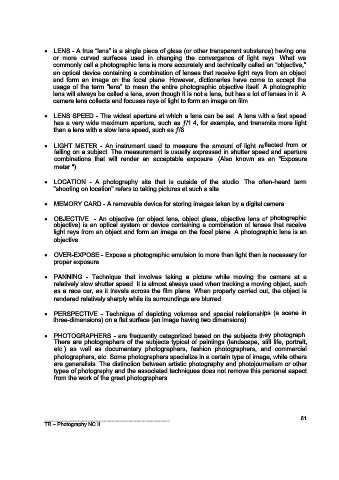Page 517 - aREA ix eXHIBITS
P. 517
LENS - A true “lens” is a single piece of glass (or other transparent substance) having one
or more curved surfaces used in changing the convergence of light rays. What we
commonly call a photographic lens is more accurately and technically called an “objective,”
an optical device containing a combination of lenses that receive light rays from an object
and form an image on the focal plane. However, dictionaries have come to accept the
usage of the term “lens” to mean the entire photographic objective itself. A photographic
lens will always be called a lens, even though it is not a lens, but has a lot of lenses in it. A
camera lens collects and focuses rays of light to form an image on film.
LENS SPEED - The widest aperture at which a lens can be set. A lens with a fast speed
has a very wide maximum aperture, such as ƒ/1.4, for example, and transmits more light
than a lens with a slow lens speed, such as ƒ/8.
LIGHT METER - An instrument used to measure the amount of light reflected from or
falling on a subject. The measurement is usually expressed in shutter speed and aperture
combinations that will render an acceptable exposure. (Also known as an "Exposure
meter.")
LOCATION - A photography site that is outside of the studio. The often-heard term
"shooting on location" refers to taking pictures at such a site.
MEMORY CARD - A removable device for storing images taken by a digital camera.
OBJECTIVE - An objective (or object lens, object glass, objective lens or photographic
objective) is an optical system or device containing a combination of lenses that receive
light rays from an object and form an image on the focal plane. A photographic lens is an
objective.
OVER-EXPOSE - Expose a photographic emulsion to more than light than is necessary for
proper exposure.
PANNING - Technique that involves taking a picture while moving the camera at a
relatively slow shutter speed. It is almost always used when tracking a moving object, such
as a race car, as it travels across the film plane. When properly carried out, the object is
rendered relatively sharply while its surroundings are blurred.
PERSPECTIVE - Technique of depicting volumes and spacial relationships (a scene in
three-dimensions) on a flat surface (an image having two dimensions).
PHOTOGRAPHERS - are frequently categorized based on the subjects they photograph.
There are photographers of the subjects typical of paintings (landscape, still life, portrait,
etc.) as well as documentary photographers, fashion photographers, and commercial
photographers, etc. Some photographers specialize in a certain type of image, while others
are generalists. The distinction between artistic photography and photojournalism or other
types of photography and the associated techniques does not remove this personal aspect
from the work of the great photographers.
________________________________________________ 61
TR – Photography NC II

